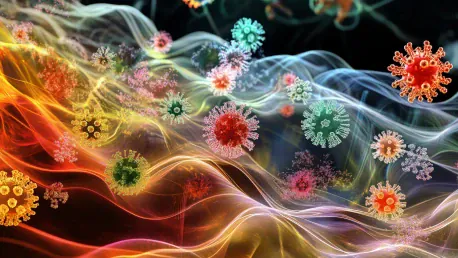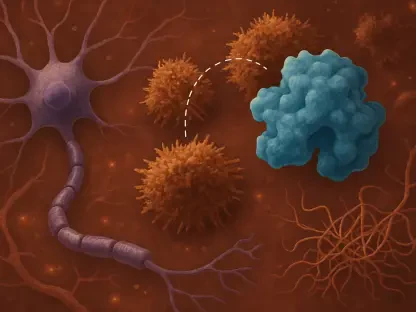Nanomedicine has made remarkable strides since the 1950s, revolutionizing the way drugs are delivered within the body. A recent breakthrough by scientists at ETH Zürich leverages sound waves to control microscopic flower-like zinc oxide particles for targeted drug delivery, marking a significant leap in nanotechnology and personalized medicine.
The Evolution of Drug Delivery
Traditional Methods and Their Limitations
Traditional drug delivery methods, such as oral ingestion and injections, distribute medication systemically throughout the body. These methods often require higher doses due to metabolic losses and interactions with healthy tissues, leading to unwanted side effects. Economically speaking, the need for such large doses increases both production costs and strain on manufacturing chains. Moreover, adverse side effects not only compromise patient quality of life but may also limit the dosage that can be safely administered, thereby reducing the treatment’s overall effectiveness.
The primary challenge with systemic delivery is the sheer lack of specificity. In situations like chemotherapy, the drugs do not discriminate between healthy and diseased cells, leading to a wide range of detrimental side effects that patients must endure. The scattered approach fails to exploit the advantages of localized treatment, including reduced toxicity and enhanced efficacy. As a result, there has been a pressing need for innovations that can deliver drugs directly to the target cells, minimizing harm to surrounding healthy tissues.
The Need for Targeted Drug Delivery
Targeted drug delivery aims to address these challenges by concentrating medication in specific areas, potentially transforming patient outcomes, particularly in treatments like chemotherapy, which affects both cancerous and healthy cells. This technique focuses on selective drug deposition at the disease site, enhancing therapeutic outcomes while minimizing side effects. The targeted approach ensures that smaller drug dosages provide effective treatment, leading to improved patient compliance and overall healthcare cost reductions.
In addition, the technology offers several strategic advantages. For example, reducing systemic exposure can alleviate the risk of drug resistance, a common dilemma in long-term treatments like chemotherapy. By concentrating the medication at the disease site, targeted drug delivery can disrupt the biological pathways of the disease more effectively, offering a compelling solution to one of medicine’s most resilient challenges. This increased precision has the potential to revolutionize chronic disease management, particularly in cases like cancer, cardiovascular diseases, and localized infections where high specificity and efficiency are crucial.
Targeted Drug Delivery Techniques
Electric and Magnetic Fields
Electric and magnetic fields can direct drugs to target locations, provided the carriers or drugs respond to these fields. However, challenges such as limited tissue penetration depth and the need for electrodes and magnets limit their effectiveness for deep tissue applications. Magnetic fields, for example, can influence magnetic nanoparticles to travel to specific body sites. But, the efficacy of this approach diminishes considerably with distance, as deeper tissues pose significant obstacles for field propagation.
Another concern revolves around the ancillary equipment required. Electromagnetic setups often demand intricate configurations of magnets, transducers, and electrodes, making the systems less portable and less applicable in a wide range of clinical settings. In addition, there is the persistent problem of unintended nanoparticle accumulation; without focused magnetic fields or precision targeting, magnetic nanoparticles may lodge themselves in untargeted tissues, carrying the risk of localized toxicity.
Sound Waves
Ultrasound can push drugs towards target areas using acoustic radiation forces. Drugs encapsulated in micro or nanobubbles are guided by sound waves and released at the target site by changing the sound wave frequency. This method enhances drug permeability but requires precise frequency control.
The acoustic method is groundbreaking because it offers more targeted penetration, even in deep tissues, without the need for invasive electrodes or magnetic fields. Ultrasound waves can be finely tuned to affect only the encapsulated drugs without disturbing the surrounding tissue. This adaptability makes ultrasound particularly useful in sensitive areas like the brain. However, despite its advantages, ultrasound-based drug delivery is not without challenges. Mechanical scattering of sound waves off bones can disrupt drug release accuracy, and tissue heterogeneity can lead to varied acoustic impedance, complicating control mechanisms.
Chemical and Biological Targeting
Chemical targeting leverages molecules’ response to specific conditions, while biological targeting uses markers like antibodies to bind to specific proteins in diseased cells. These methods, although not needing external stimuli, are challenging to implement due to the scarcity of naturally occurring molecules for selective targeting. The chemical method uses pH-sensitive or enzyme-responsive carriers that dissolve or deform under specific conditions, releasing the drug. This pH-sensitive feature becomes crucial in environments like tumor tissues, where conditions drastically differ from surrounding healthy tissues.
Biological targeting, on the other hand, utilizes the body’s immune mechanisms to deliver drugs. Antibody-drug conjugates, for example, are engineered to latch onto specific antigens present on cancer cells. This provides an unparalleled level of specificity, turning the body’s natural defense mechanism into targeted drug delivery vehicles. However, bioengineering these precision molecules poses considerable challenges, from manufacturing complexities to the risk of immunogenicity—where the body’s immune system starts rejecting the engineered components. This necessitates a balanced approach combining chemical and biological methods to increase efficacy and safety.
Innovative Solution: Microscopic Flowers
Hierarchical Nanostructures (HNS)
The ETH Zürich team developed hierarchical nanostructures (HNS) controlled by sound waves. These microscopic, flower-like zinc oxide particles represent a significant departure from previous bubble-based methods, addressing conventional drug delivery limitations. The team was guided by the limitations of existing solutions that included the dynamic nature of bodily fluids and the need for complex setups to control and track bubbles.
HNS push the boundaries of nanomedicine by offering a structure that can be easily manipulated by sound waves. The team leader, Prof. Daniel Razansky, and his colleagues envisioned HNS overcoming the obstacles posed by traditional carriers. The microscopic zinc oxide structures are not just tiny containers; they are intricately designed systems built to interact with acoustic fields, enhancing both their targeting precision and tracking capability. This represents a paradigm shift in nanotechnology-enabled medicine.
Material and Structure of HNS
HNS are crafted from biocompatible materials like zinc oxide and assembled into flower-like structures. These structures enhance functionality, allowing for multiple surfaces for drug attachment and sound wave reflection for imaging. The unique assembly of 2D nanosheets into hierarchical forms furnishes the particles with extraordinary surface areas—almost 250 times larger than those of their solid counterparts.
Gadolinium atoms can be incorporated for magnetic resonance imaging (MRI), while elements like gold and polydopamine facilitate optical and optoacoustic imaging. The intricate flower-like shape offers a dual advantage: multiple surface areas for enhanced drug loading capacity and greater interaction with acoustic waves for improved imaging. These structural benefits make HNS not only potent drug carriers but also exceptional tracing agents suitable for dual imaging modalities. The compounded utility holds promise for multifunctional therapeutic systems equipped for simultaneous diagnostics and treatment.
Functional Mechanisms and Advantages
Enhanced Control and Tracking
The unique geometry of HNS offers up to 250 times the surface area of solid particles of similar size. Sound waves interacting with HNS create tiny whirlpools in blood flow, grouping particles together for easier tracking and control. The meticulously engineered structure ensures that the particles can maneuver dynamically within the body, providing healthcare providers with the control they need to target diseased cells accurately.
These particles are designed to respond to acoustic fields by generating localized micro vortices, which consolidate them and make them easier to track through the complex landscapes of blood circulation. This novel approach elegantly solves the long-standing challenge of nanoparticle control in a fluid-dynamic environment. By enhancing maneuverability and visibility, HNS set a new standard in nanoparticle-based treatments.
Proven Effectiveness
HNS effectiveness was demonstrated in mock blood flow conditions, microfluidic channels, and in vivo mouse tests, showcasing significant improvement over previous methods. This design counters high-velocity fluid drag, improving control compared to bubble-based systems. The researchers’ validation of their approach in a range of settings—from controlled lab environments to live animal models—underpins the robustness of their design.
The consistency in performance across various tests highlights the reliability and efficacy of HNS. In practice, this means that patients could potentially benefit from more precise, safer drug delivery systems, significantly lowering the risk of side effects and improving treatment outcomes. The ETH Zürich study marks a promising stride towards making these innovations a reality in clinical settings, poised to revolutionize targeted therapies on multiple fronts.
Applications and Future Directions
Beyond Drug Delivery
HNS have potential beyond drug delivery, including applications in wastewater purification. Their biocompatibility and minimal blood toxicity make them promising candidates for various applications. For instance, the microscopic flowers can be tailored to capture and neutralize pollutants in contaminated water supplies. This dual functionality—medical and environmental—spotlights their versatility and opens avenues for broader impactful uses.
Current explorations into wastewater treatment indicate that these flower-like structures could efficiently capture heavy metals and other contaminants, turning a nanomedicine breakthrough into a powerful environmental tool. As society looks to leverage technology for sustainable solutions, the broader implications of HNS could redefine the scope of nanotechnology, making monumental impacts across multiple sectors.
Future Developments
Since the 1950s, the field of nanomedicine has seen remarkable progress, fundamentally transforming how drugs are administered within the human body. A recent pioneering advancement by researchers at ETH Zürich showcases the use of sound waves to manipulate microscopic, flower-shaped zinc oxide particles for precision drug delivery. This method represents a significant leap forward in the realms of nanotechnology and personalized medicine.
By harnessing the power of acoustics, scientists can now guide these tiny particles to deliver medication directly to targeted areas, thus enhancing the efficacy of treatment while minimizing side effects. The zinc oxide particles, designed to resemble tiny flowers, can navigate through the body’s complex systems with high precision when directed by sound waves.
This innovative approach not only increases the precision of drug delivery but also opens new avenues for treating a variety of conditions more effectively. Personalized medicine, which aims to tailor treatments to individual patients, stands to benefit immensely from this development. The ability to control drug delivery so precisely could lead to treatments that are more efficient, less invasive, and specifically tailored to the needs of each patient.
Overall, this breakthrough highlights the continuous advancements in nanomedicine and nanotechnology, promising a future where treatments are more targeted and personalized, potentially leading to better outcomes for patients worldwide.









